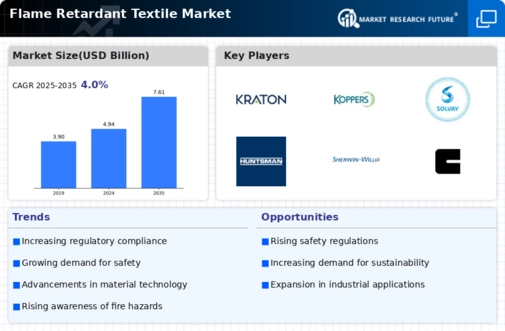Increasing Safety Regulations
The Flame Retardant Textile Market is experiencing a surge in demand due to the implementation of stringent safety regulations across various sectors. Governments and regulatory bodies are mandating the use of flame retardant textiles in industries such as construction, automotive, and aviation to enhance safety standards. For instance, the National Fire Protection Association has established codes that require flame-resistant materials in specific applications. This regulatory push is likely to drive the market, as manufacturers seek to comply with these standards, thereby increasing the adoption of flame retardant textiles. The market is projected to grow at a compound annual growth rate of approximately 5.5% over the next few years, reflecting the increasing emphasis on safety and compliance.
Growing Awareness of Fire Safety
The Flame Retardant Textile Market is benefiting from a heightened awareness of fire safety among consumers and businesses alike. As incidents of fire-related accidents continue to garner media attention, there is a growing demand for textiles that offer enhanced fire resistance. This awareness is particularly pronounced in sectors such as hospitality, healthcare, and residential construction, where the risk of fire is a significant concern. Consequently, manufacturers are responding to this demand by developing a wider range of flame retardant textiles, which is likely to drive market growth. The increasing focus on fire safety is expected to result in a market expansion of approximately 4.5% over the next few years.
Expansion of the Construction Industry
The expansion of the construction industry is a crucial driver for the Flame Retardant Textile Market, as the demand for fire-resistant materials in building projects continues to rise. With urbanization and infrastructure development on the rise, there is an increasing need for textiles that can withstand fire hazards in commercial and residential buildings. Flame retardant textiles are being utilized in various applications, including curtains, upholstery, and insulation materials. The construction sector is projected to grow at a rate of 7% annually, which will likely bolster the demand for flame retardant textiles. This trend underscores the importance of fire safety in construction practices and the role of flame retardant materials in ensuring compliance with safety regulations.
Rising Demand in the Automotive Sector
The automotive sector is a significant driver for the Flame Retardant Textile Market, as manufacturers increasingly incorporate flame retardant materials into vehicle interiors. With the growing focus on passenger safety and the need to meet regulatory requirements, automotive companies are investing in flame retardant textiles for seat covers, carpets, and other interior components. The market for automotive textiles is expected to reach USD 30 billion by 2026, with a substantial portion attributed to flame retardant materials. This trend indicates a robust demand for flame retardant textiles, as automakers prioritize safety and compliance with fire safety standards, thereby propelling the overall market forward.
Technological Innovations in Textile Manufacturing
Technological advancements in textile manufacturing are playing a pivotal role in shaping the Flame Retardant Textile Market. Innovations such as nanotechnology and advanced polymer chemistry are enabling the development of more effective and durable flame retardant textiles. These technologies not only enhance the performance of flame retardant materials but also allow for the creation of lightweight and comfortable fabrics. As manufacturers adopt these cutting-edge technologies, the market is likely to witness an increase in product offerings that meet diverse consumer needs. The integration of technology in textile production is expected to contribute to a market growth rate of around 6% annually, reflecting the industry's adaptability and innovation.

















Leave a Comment